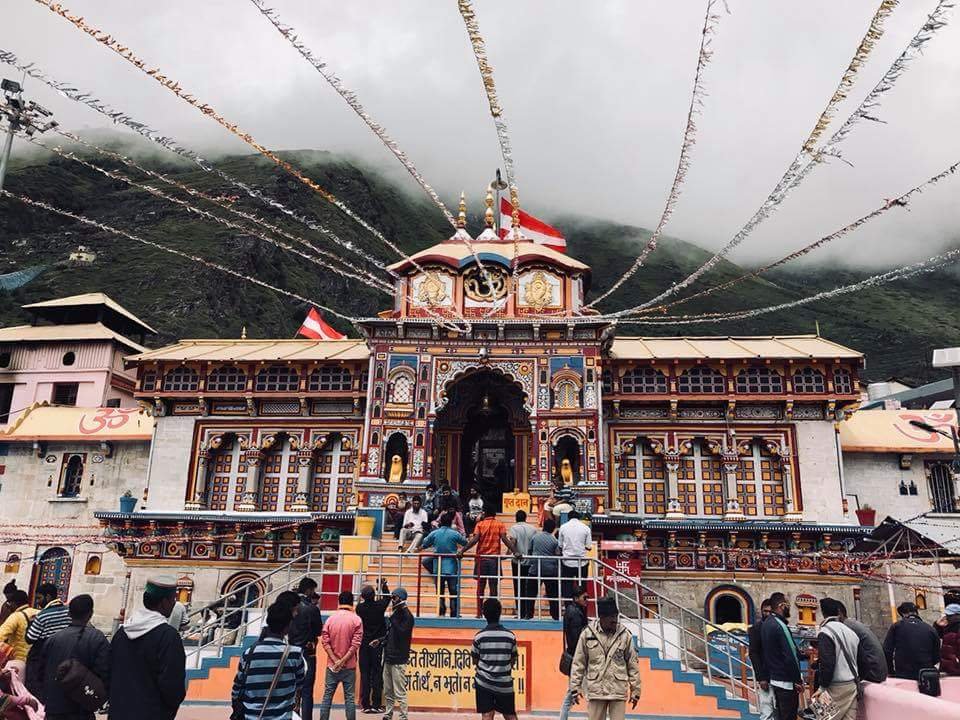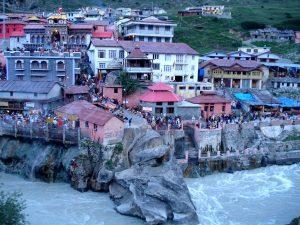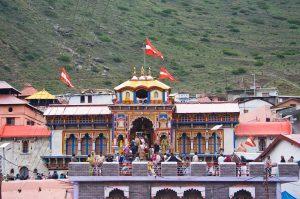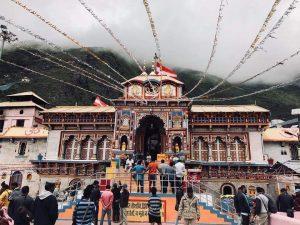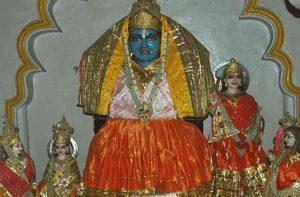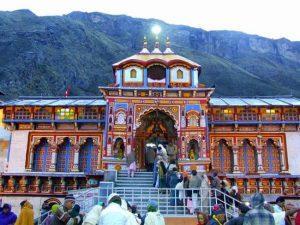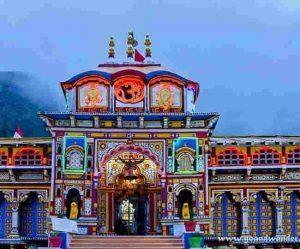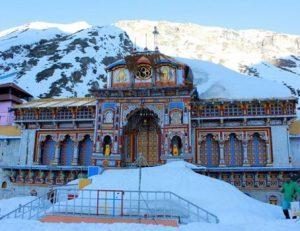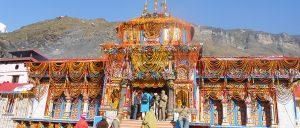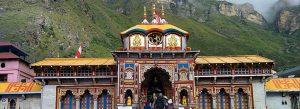Badrinath Temple, Chamoli, Uttarakhand
| Date built: | 7th century C.E |
|---|---|
| Deity: | Badrinath (Vishnu) |
| Architectural style: | – |
| Major festivals | – |
| Locale: | Badarinath |
| District:: | Chamoli |
| Address: | Badri to Mata Murti road, Badrinath, Uttarakhand 246422 |
| Phone | 01352741600 |
Badrinath or Badrinarayan Temple is a Hindu temple dedicated to Vishnu which is situated in the town of Badrinath in Uttarakhand, India. The temple and town form one of the four Char Dham and Chota Char Dham pilgrimage sites. The temple is also one of the 108 Divya Desams dedicated to Vishnu, who is worshipped as Badrinath—holy shrines for Vaishnavites. It is open for six months every year (between the end of April and the beginning of November), because of extreme weather conditions in the Himalayanregion. The temple is located in Garhwal hill tracks in Chamoli district along the banks of Alaknanda River at an elevation of 3,133 m (10,279 ft) above the mean sea level. It is one of the most visited pilgrimage centers of India, having recorded 1,060,000 visits.
The image of the presiding deity worshipped in the temple is a 1 m (3.3 ft) tall, the black stone statue of Vishnu in the form of Badrinarayan. The statue is considered by many Hindus to be one of eight swayam vyakta kshetras, or self-manifested statues of Vishnu.
Mata Murti Ka Mela, which commemorates the descent of river Ganges on mother earth, is the most prominent festival celebrated in the Badrinath Temple. Although Badrinath is located in North India, the head priest, or Rawal, is traditionally a Nambudiri Brahminchosen from the South Indian state of Kerala. The temple was included in the Uttar Pradesh state government Act No. 30/1948 as Act no. 16,1939, which later came to be known as Shri Badarinath and Shri Kedarnath Mandir Act. The committee nominated by the state government administers both the temples and has seventeen members on its board.
The temple is mentioned in ancient religious texts like Vishnu Purana and Skanda Purana. It is glorified in the Divya Prabandha, an early medieval Tamil canon of the Azhwar saints from the 6th–9th centuries AD.
Architecture
There is no historical record about the temple, but there is a mention of the presiding deity Badrinath in Vedic scriptures(c. 1750–500 bc). According to some accounts, the temple was a Buddhist shrine till the 8th century and Adi Shankaraconverted it to a Hindu temple.The architecture of the temple resembling that of a Buddhist vihara (temple) and the brightly painted facade which is atypical of Buddhist temples leads to the argument.Other accounts relate that it was originally established as a pilgrimage site by Adi Shankara in the ninth century. It is believed that Shankara resided in the place for six years from ad 814 to 820. He resided six months in Badrinath and the rest of the year in Kedarnath. Hindu followers assert that he discovered the image of Badrinath in the Alaknanda River and enshrined it in a cave near the Tapt Kund hot springs. A traditional story asserts that Shankara expelled all the Buddhists in the region with the help of the Parmar ruler king Kanak Pal. The hereditary successors of the king governed the temple and endowed villages to meet its expenses. The income from a set of villages on the route to the temple was used to feed and accommodate pilgrims. The Parmar rulers held the title “Bolanda Badrinath”, meaning speaking Badrinath. They had other titles, including Shri 108 Basdrishcharyaparayan Garharaj Mahimahendra, Dharmabibhab, and Dharamarakshak Sigamani.
The throne of Badrinath was named after the presiding deity; the king enjoyed ritual obeisance by the devotees before proceeding to the shrine. The practice was continued until the late 19th century. During the 16th century, the King of Garhwalmoved the murti to the present temple.When the state of Garhwal was divided, the Badrinath temple came under British rule but the king of Garhwal continued as the chairman of the management committee.The selection of priest is done after consultation between Garhwal and Travancore royal families.
The temple has undergone several major renovations due to its age and damage by an avalanche. In the 17th century, the temple was expanded by the Kings of Garhwal. After significant damage in the great 1803 Himalayan earthquake, it was largely rebuilt by the King of Jaipur.It was still under renovation as late as the 1870s but these were completed by the time of the First World War. At that time, the town was still small, consisting of only the 20-odd huts housing the temple’s staff, but the number of pilgrims was usually between seven and ten thousand.The Kumbh Meld festival held every twelve years raised the number of visitors to 50,000.The temple also enjoyed revenue from the rents owed to it by various villages bequeathed by various rajas.
During 2006, the state government announced the area around Badrinath as a no construction zone to curb illegal encroachment.
Legend / Local stories
The temple is located in Garhwal hill tracks along the banks of the Alaknanda River in Chamoli district in Uttarakhand, a state in North India. The hill tracks are located 3,133 m (10,279 ft) above the mean sea level. The Nar Parbat mountain is located opposite to the temple, while the Narayana Parbat is located behind the Neelakanta peak.
The temple has three structures: the Garbhagriha (sanctum), the Darshan Mandap (worship hall), and Sabha Mandap (convention hall).The conical-shaped roof of the sanctum, the garbhagriha, is approximately 15 m (49 ft) tall with a small cupola on top, covered with a gold gilt roof.The facade is built of stone and has arched windows. A broad stairway leads up to the main entrance, a tall, arched gateway. Just inside is a mandap, a large, pillared hall that leads to the sanctum, or main shrine area. The walls and pillars of the hall are covered with intricate carvings.
The main shrine houses the 1 m (3.3 ft) Shaligram (black stone) idol of Lord Badrinarayana, which is housed in a gold canopy under a Badri Tree. The idol of Lord Badrinarayana shows Him holding a Shankha (conch) and a Chakra (wheel) in two of His arms in a lifted posture and the other two arms resting on His lap in a Yogamudra (Padmasana) posture. The sanctum also houses images of the god of wealth—Kubera, sage Narada, Uddhava, Nar and Narayan. There are fifteen more images that are also worshipped around the temple. These include that of Lakshmi (the consort of Vishnu), Garuda (the vahana of Narayan), and Navadurga, the manifestation of Durga in nine different forms. The temple also has shrines of Lakshmi Narasimhar and for saints Adi Shankara (ad 788-820), Nar and Narayan,Ghantakarna, Vedanta Desika and Ramanujacharya. All the idols of the temple are made of black stone.
The Tapt Kund, a group of hot sulfur springs just below the temple, are considered to be medicinal; many pilgrims consider it a requirement to bathe in the springs before visiting the temple. The springs have a year-round temperature of 55 °C (131 °F), while outside temperature is typically below 17 °C (63 °F) all year round.The two water ponds in the temple are called Narad Kund and Surya Kund.
According to Hindu legend, god Vishnu sat in meditation at this place. During his meditation, Vishnu was unaware of cold weather. Lakshmi, his consort, protected him in the form of the Badri tree (jujube or Indian date). Pleased by the devotion of Lakshmi, Vishnu named the place Badrika Ashram. According to Atkinson (1979), the place used to be a jujube forest, which is not found there today. Vishnu in the form of Badrinath is depicted in the temple sitting in the padmasana posture. According to the legend, Vishnu was chastised by sage Narada, who saw Vishnu’s consort, Lakshmi, massaging his feet. Vishnu went to Badrinath to perform austerity, meditating for a long time in padmasana.
The Vishnu Purana narrates another version of the origins of Badrinath. According to the tradition, Dharam had two sons, Nar, and Narayan—both of which are modern names of Himalayan mountains. They chose the place to spread their religion and each of them wed the spacious valleys in the Himalayas. Searching for an ideal place to set up a hermitage, they came across the other four Badris of the Pancha Badri, namely Bridha Badri, Yog Bhadri, Dhyan Badri and Bhavish Badri. They finally found the hot and cold spring behind the Alaknanda River and named it Badri Vishal.
Photo Gallery
How to Reach:
Contact Details
Official Address

